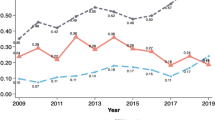Abstract
The United States is becoming an increasingly service-oriented economy. The rapid growth of the tertiary sector has been accompanied by equally rapid technological change in the area of communications, information and data processing. What are the implications for regional growth policies? Are services becoming more “footloose” in their locational orientation and amenable to policy manipulation? This paper tests these propositions by applying, to the tertiary sector, a stochastic model reflecting central-place or other market-oriented theory. The results indicate that, in 1969, the model accurately predicted service activity in 155 Bureau of Economic Analysis areas. Despite recent developments in the sector, service activity remains market oriented. As such, these activities are likely to respond to, but not initiate, regional growth. Unlike export-base or infrastructure stimulation, growth through service development does not represent ageneral policy prescription.
Similar content being viewed by others
References
Beckman, M., “City Hierarchies and the Distribution of City Size,”Economic Development and Cultural Change, June, 1958, pp. 243–8.
Berry, B. and Garrison, W., “Alternative Explanations of Urban Rank-Size Relationships,”Annals of the Association of American Geographers, March 1958, pp. 83–91.
Berry, B. and Garrison, W. “A Note on Central Place Theory and the Range of a Good,”Economic Geography 34, No. 3 (1958), pp.304–11.
Berry, B. and Garrison, W., “Recent Developments of Central Place Theory,”Papers and Proceedings of the Regional Science Association 4 (1958), pp. 107–120.
Chinitz, B., “National Policy for Regional Development,” in J. F. Kain and J. R. Meyer (eds.),Essays in Regional Economics, Cambridge: Harvard University Press, 1971, pp. 21–39.
Christaller, W.,Die zentralen Orte in Suddeutschland, Jena: Gustav Fischer, 1933.
Darwent, D., “Growth Poles and Groth Centers in Regional Planning—A Review,”Environment and Planning, vol. 1, 1969, pp. 5–32.
Duncan, O., “Service Industries and the Urban Hierarchy,”Papers and Proceedings of the Regional Science Association 5 (1959), pp. 105–120.
Farrar, D. and Glauber, R., “Multicollinearity in Regression Analysis The Problem Revisited,”The Review of Economics and Statistics, February, 1967, pp. 92–107.
Hansen, N.,Rural Poverty and the Urban Crisis, Bloomington: Indiana University Press, 1970.
Heilbrun, J.,Urban Economics and Public Policy, New York: St. Martin's Press, 1974.
Isard, W.,Location and Space Economy, Cambridge: The M.I.T. Press, 1956.
Lösch, A.,Die Raumliche Ordnug der Wirtschaft, translated by W. Woglom and W. Stolper asThe Economics of Location, New Haven: Yale University Press, 1954.
Nourse, H.Regional Economics, New York: McGraw-Hill, 1968.
Ullman, E., “A Theory of Location for Cities,”The American Journal of Sociology XLVI, No. 6 (1941), pp. 853–864.
U. S. Bureau of Labor Statistics,Survey of Consumer Expenditures, 1960–61, Washington, D. C.: Government Printing Office, 1964.
U. S. Department of Commerce, 1970 Statistical Abstract of the United States, Washington, D. C.: Government Printing Office.
U. S. Department of Commerce,Survey of Current Business, May, 1973.
Winsborough, H., “Variations in Industrial Composition with City Size,”Papers and Proceedings of the Regional Science Association 5 (1959), pp. 121–131.
Yamane, T.,Statistics, An Introductory Analysis, New York: Harper and Row, 1967.
1972 OBERS Projections of Regional Activity in the United States, prepared by the Bureau of Economic Analysis, U. S. Department of Commerce, and the Economic Research Service, U. S. Department of Agriculture, for the U. S. Water Resources Council, Washington, D.C.: a. vol. 1,Concepts, Methodology and Summary Data, b. vol. 2,BEA Economic Areas.
Author information
Authors and Affiliations
Additional information
This paper summarizes results of a project conducted for Jack Faucett Associates and the Economic Development Administration, U. S. Department of Commerce.
Rights and permissions
About this article
Cite this article
Riefler, R.F. Implications of service industry growth for regional development strategies. Ann Reg Sci 10, 88–103 (1976). https://doi.org/10.1007/BF01303245
Issue Date:
DOI: https://doi.org/10.1007/BF01303245




